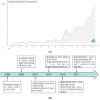Trends in Nutrition Research for Sarcopenia: A Bibliometric Analysis
- PMID: 36296946
- PMCID: PMC9612349
- DOI: 10.3390/nu14204262
Trends in Nutrition Research for Sarcopenia: A Bibliometric Analysis
Abstract
Sarcopenia is age-related, pathophysiological muscle atrophy. Research regarding nutrition treatment of sarcopenia has developed rapidly, particularly as populations age. We evaluated the development of trends in this field using a bibliometric analysis. Articles up to July 2022 were searched in the Scopus database. Bibliographic information from the selected publications, such as countries, citations, world maps, institutions, authors, journals, and keywords, were converted and analyzed automatically using the "bibliometrix" package in R environment (version 4.2.0). We identified 368 Scopus articles from 1998-2021. According to citation analyses, 27 documents received more than 100 citations. Bibliometric analysis based on the literature included in this study revealed that South Korea (61 publications), United States (50), Japan (35), China (30), and Italy (20) contributed the most publications. Tehran University of Medical Science (19 records, 2.55% of articles) contributed the most publications. The most productive author was Landi, with eight articles (2.17% of articles). The publications were located in 196 journals, with Nutrients having the most publications (30, 8.15% of articles). The curves representing keywords "sarcopenia" and "aged" were the most apparent. Our analysis suggested that global nutrition and sarcopenia-related research increased rapidly from 2001 to 2021, demonstrating that this was a promising area of future research that could benefit from continued advances. Future research may focus on the effects of age and sex as well as intervention effectiveness, particularly exercise and nutrition supplementation.
Keywords: bibliometrics; nutrition; older people; quantitative analyses; sarcopenia.
Conflict of interest statement
There are no conflict of interest to declare.
Figures








Similar articles
-
Research Trends in the Effect of Caffeine Intake on Fat Oxidation: A Bibliometric and Visual Analysis.Nutrients. 2023 Oct 10;15(20):4320. doi: 10.3390/nu15204320. Nutrients. 2023. PMID: 37892395 Free PMC article. Review.
-
A bibliometric analysis of inflammation in sarcopenia from 2007 to 2022.Exp Gerontol. 2023 Nov;183:112316. doi: 10.1016/j.exger.2023.112316. Epub 2023 Oct 19. Exp Gerontol. 2023. PMID: 37862732
-
Bibliometric Analysis of the Knowledge Base and Future Trends on Sarcopenia from 1999-2021.Int J Environ Res Public Health. 2022 Jul 21;19(14):8866. doi: 10.3390/ijerph19148866. Int J Environ Res Public Health. 2022. PMID: 35886713 Free PMC article. Review.
-
Telomerase-related advances in hepatocellular carcinoma: A bibliometric and visual analysis.World J Gastroenterol. 2024 Mar 7;30(9):1224-1236. doi: 10.3748/wjg.v30.i9.1224. World J Gastroenterol. 2024. PMID: 38577190 Free PMC article.
-
Research trends and hotspots of exercise for people with sarcopenic: A bibliometric analysis.Medicine (Baltimore). 2023 Dec 15;102(50):e35148. doi: 10.1097/MD.0000000000035148. Medicine (Baltimore). 2023. PMID: 38115285 Free PMC article.
Cited by
-
Psoas muscle CT radiomics-based machine learning models to predict response to infliximab in patients with Crohn's disease.Ann Med. 2025 Dec;57(1):2527954. doi: 10.1080/07853890.2025.2527954. Epub 2025 Jul 5. Ann Med. 2025. PMID: 40616584 Free PMC article.
-
Understanding the Complexity of Hypertension with Sarcopenia by Scientometric Analysis.J Multidiscip Healthc. 2024 Dec 30;17:6211-6228. doi: 10.2147/JMDH.S498799. eCollection 2024. J Multidiscip Healthc. 2024. PMID: 39759086 Free PMC article.
-
Predictive value of three nutritional indexes for disease activity in patients with inflammatory bowel disease.Ann Med. 2025 Dec;57(1):2443256. doi: 10.1080/07853890.2024.2443256. Epub 2024 Dec 20. Ann Med. 2025. PMID: 39705015 Free PMC article.
-
Prevention and Treatment of Sarcopenia: Multidisciplinary Approaches in Clinical Practice.Nutrients. 2023 Apr 30;15(9):2163. doi: 10.3390/nu15092163. Nutrients. 2023. PMID: 37432270 Free PMC article.
-
Mapping the global research landscape on malnutrition for patients with chronic kidney disease: a visualization analysis.J Health Popul Nutr. 2023 Sep 23;42(1):101. doi: 10.1186/s41043-023-00445-8. J Health Popul Nutr. 2023. PMID: 37742012 Free PMC article.
References
-
- Shlisky J., E Bloom D., Beaudreault A.R., Tucker K., Keller H.H., Freund-Levi Y., A Fielding R., Cheng F.W., Jensen G.L., Wu D., et al. Nutritional Considerations for Healthy Aging and Reduction in Age-Related Chronic Disease. Adv. Nutr. Int. Rev. J. 2017;8:17–26. doi: 10.3945/an.116.013474. - DOI - PMC - PubMed
-
- Jang Y.C., Liu Y., Hayworth C.R., Bhattacharya A., Lustgarten M.S., Muller F.L., Chaudhuri A., Qi W., Li Y., Huang J.-Y., et al. Dietary restriction attenuates age-associated muscle atrophy by lowering oxidative stress in mice even in complete absence of CuZnSOD. Aging Cell. 2012;11:770–782. doi: 10.1111/j.1474-9726.2012.00843.x. - DOI - PMC - PubMed
MeSH terms
Grants and funding
LinkOut - more resources
Full Text Sources

